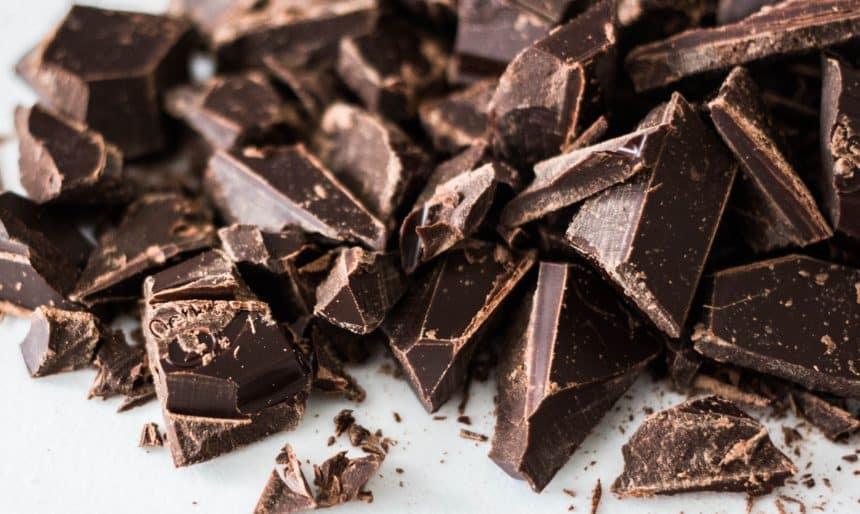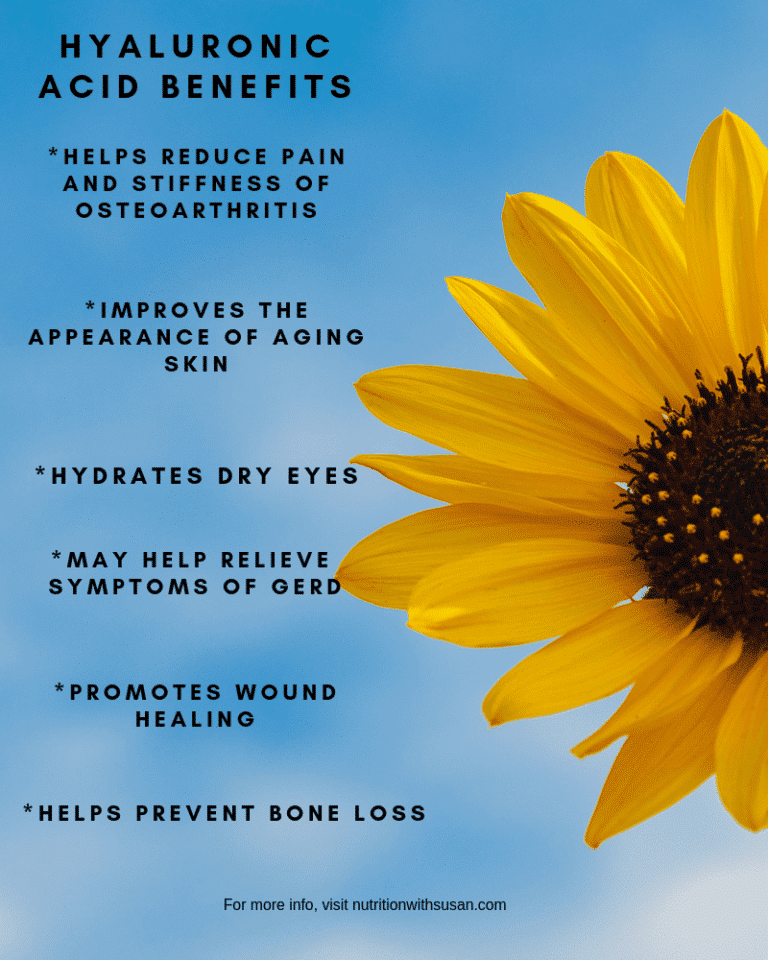Introduction
Arthritis is a pain — no pun intended! Living with a chronic disease is no small feat. It takes a lot of determination and willpower not to just throw your hands up in the air and give up any hope of getting better.
However, you never know when you’re going to run across an article or podcast that might make a difference in your life. This happened to me recently — I was sitting on my couch in my jammies, scrolling through my news feed when I ran across an article on hyaluronic acid and arthritis.
I was intrigued — enough to start doing some digging and write this article. Keep on reading to learn what I found out!
What is Hyaluronic Acid?
Hyaluronic acid (HA) or Hyaluronan, is a clear lubricating substance produced by the body and found in every connective tissue and organ such as the skin, synovial fluid, blood vessels, brain, cartilage, heart valves, and umbilical cord.
The synovial fluid has the highest concentration of HA in the body at 3-4 mg/ml.
Naturally produced by the body, it lubricates joints, plumps up the skin by retaining collagen and increasing moisture, increases flexibility and elasticity.
You have plenty of this stuff when you’re young — think of a baby bouncing around the house like a rubber ball — no adult could do the same without breaking an arm or a leg!
Or the plump, smooth, lineless skin of a child — people pay big bucks for skin like this after they reach a certain age.
Hyaluronic acid is responsible for both. Unfortunately, as we age, our body produces less and less HA, resulting in wrinkles and joint problems.
Are there foods that increase Hyaluronic Acid
Yes, there are foods that can promote high HA levels in the body. It’s best to include a variety of these foods in your diet as they work together synergistically.
Bone Broth

Well known for its anti-inflammatory properties and collagen-producing abilities, bone broth is one of the best sources of HA around.
It’s full of so many nutrients that most of us don’t get in our diet on a daily basis, since eating bones is not something we do everyday.
One of the best things about it is it’s really easy to make at home. Try out this Easy Peasy Bone Broth recipe and feel free to get creative and add your own twist to it.
Leafy green vegetables

Green leafys like spinach and kale are great sources of magnesium, which is a catalyst in the production of HA. If your magnesium levels are low, it’s a good bet your HA is too.
There are easy ways to add greens to your diet – smoothies, salads, casseroles, soups, and stews to name just a few. No excuses for not slipping a few greens into your daily routine.
Nuts

Nuts, especially almond, cashews, Brazil nuts, and pecans, are a great source of magnesium and a HA booster. Almonds are a star ingredient in this recipe for Salmon Roasted with Butter and Almonds.
Dark Chocolate

Dark chocolate helps amp up HA production due to its magnesium and zinc content. Check out this recipe for Dark Chocolate Coconut Almond Bites for an easy, healthy, and tasty way to boost your HA.
Root Vegetables

Root vegetables both contain some HA naturally and also help increase it in the body due to their high nutrient content. Sweet potatoes are an excellent choice as they’re higher in magnesium.
Fruit

Eating fresh fruit is a good way to ramp up your HA production, especially fruit high in Vitamin C like oranges, tomatoes, avocados, and mangoes to name a few. Their vitamin C/magnesium combo is a good HA booster.
Bananas are one of the few fruits that naturally contain not only some HA, but vitamin C and magnesium as well.
Peppers

Peppers are loaded with Vitamin C making them a good HA producer. Colorful and easy to add to recipes, peppers are a simple way to increase your HA.
6 Benefits of Hyaluronic Acid

Peppers are loaded with Vitamin C making them a good HA producer. Colorful and easy to add to recipes, peppers are a simple way to increase your HA.
Reduces pain and stiffness of osteoarthritis
You’d think with all the advances in modern medicine, someone would have found a magic bullet to eliminate the often crippling pain and stiffness associated with arthritis.
Although it’s not magic, hyaluronic acid may help relieve the pain and stiffness of osteoarthritis. People with osteoarthritis tend to have low amounts of HA in their synovial fluid.
Intra-articular injections of HA have long been used to restore HA levels in knee joints. HA helps protect your cartilage and decreases levels of anti-inflammatory substances such as prostaglandin E2 resulting in less pain and inflammation.
Oral Hyaluronic Acid shows promise for OA pain relief
A Japanese study of 33 patients with knee pain who were given 240 mg/day of HA or placebo for 8 weeks found the HA group showed significant improvement in joint pain and stiffness.
Another study of 37 Americans with OA of the knees were given 200 mg/day orally or a placebo for 8 weeks with the HA group showing significant improvements in scores for ADLs and overall performance scores.
In a 2015 study, 72 patients with OA were given either a liquid HA mixture or placebo for 4 weeks (225 mg HA/day the first 2 weeks, then 150 mg/day the last 2 weeks. No improvement in knee pain was reported in the placebo group, however, significant improvement in pain relief was seen in the HA group.
Bottom Line: HA may help reduce pain and stiffness in osteoarthritis of the knee.
HA for anti-aging
Hyaluronic acid is excellent for hydrating and plumping up the skin. You know that dewy, silky smooth skin you had in your 20’s – well, you have HA to thank for that.
Topical serums containing HA help reduce water loss, thereby improving your skin’s appearance. HA naturally reduces the signs of aging by decreasing epidermal water loss from sun exposure or dry flaky skin.
A 2014 randomized, double-blind study found that topical HA-containing products used consistently for 30 days improved the appearance of wrinkled, saggy skin in 40 adult females with mild – moderately aged skin.
Still another 2014 randomized study found that HA supplements gave users more supple, radiant, wrinkle-free skin when used over a 12 week period.
Bottom Line: HA may worth adding to your anti-aging toolbox.
Hyaluronic Acid for dry eye
HA is found naturally in the aqueous humor and vitreous of the eye. It is useful in retaining water — studies show that it can bind up to 1000 times its weight in water, making it a useful rewetting agent.
It also helps stabilize the tear film in the eye which along with its wound-healing capabilities, makes it very useful in the treatment of dry eye, improving vision in post-surgical patients, and healing corneal abrasions.
Bottom Line: Keep some HA drops handy in your medicine cabinet.
HA may soothe Gastoesophageal Reflux Disease (GERD)
GERD or reflux disease occurs when stomach contents are regurgitated back up into the throat, resulting in pain and potential damage to the esophageal lining.
HA has shown promise in being able to alleviate GERD symptoms and help heal the esophagus.
A randomized double-blind study in adults with nonerosive GERD who were treated with an oral HA + Chondroitin-Sulfate(CS) combo showed improved symptoms compared with those on placebo.
Currently, there is a clinical trial in the works to test the effectiveness of a combination of HA, CS, and Magnesium Trisilicate on adults with GERD. Stay tuned!
Bottom Line: An HA Chondroitin combo may soothe the symptoms of GERD.
HA may promote wound healing
HA may be beneficial for wound healing due to its anti-inflammatory and anti-bacterial properties.
A recent study with 43 patients with acute wounds with HA applied either as a cream or a dressing showed improvement in all wounds with 56% resulting incomplete wound healing.
In a rat study of 40 rats with a surgical site infection, 1 group was treated with HA + antibiotic, the control group was given an antibiotic alone. The HA group showed a significant reduction in surgical site infections compared to the control group
Bottom Line : HA may effectively aid in wound healing.
HA may help prevent bone loss
One of HA’s roles in bone tissue is the formation of the thick, cushiony cartilage at the end of your bones which helps bones resist everyday wear and tear.
HA also is involved in osteoblast activity and bone resorption
Hyaluronic acid supplements may help improve bone density and protect against osteoporosis.
A 2013 rat study showed that oral HA supplements significantly reduced bone loss associated with mild osteopenia. Other rat studies have also indicated HA is beneficial for bone loss.
Bottom Line: Oral and injectable HA may be beneficial in protecting against bone loss and osteoporosis.
Side effects of Hyaluronic Acid
HA is generally recognized as safe with few reported side effects. Allergic reactions are rare as it is made naturally in your body.
Injections into the joint may cause redness and swelling. HA may increase eye pressure if injected into the eye. These symptoms usually resolve within 48-72 hours.
However, not enough is known about its safety for use during pregnancy or breastfeeding so it may be a good idea to avoid using it during this time.
Cancer cells may be sensitive to HA so supplementation could stimulate their growth. If you have a history of cancer, it may be advisable to avoid taking HA supplements.
Bottom Line: HA appears to be a safe supplement to use but just be cautious if you’re pregnant, breastfeeding, or have a history of cancer.
But wait a minute — what about Hyaluronic Acid and Rheumatoid Arthritis?
Can HA help alleviate the pain and stiffness you feel with RA?
Maybe. There are not a ton of studies out there but there are a few.
In a study of 20 RA patients who also had osteoarthritis of the knee, intra-articular injection of HA was found to be beneficial
A 2015 study found that intra-articular injections of HA were 1.5 times more effective than Naproxen and 3.5 times more effective than acetaminophen.
Bottom Line: HA injections may be effective in the relieving pain and stiffness associated with OA, but the jury’s still out on RA — more research appears to be needed.
Hyaluronic Acid Dosage
Skin – 120-140 mg/day for at least one month may improve skin hydration and reduce wrinkles. HA applied directly to a wound may reduce wound size and pain faster than a placebo
Joints – oral supplement dosage of 80 -200 mg/day for at least 2 months may reduce knee pain due to osteoarthritis; HA injections to the knee given by your healthcare provider may also be effective for OA.
Dry eye – eye drops containing 0.2 – 0.4% HA may be effective in relieving dry eye symptoms.
Conclusion
Hyaluronic acid appears to be a safe and effective option for the treatment of joint pain and stiffness associated with osteoarthritis.
It also may be a viable alternative in the treatment of aging skin, wound healing, dry eye, bone loss, and GERD.
It’s definitely worth considering adding to your treatment arsenal.


